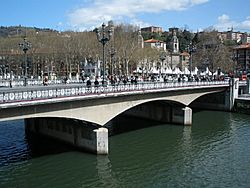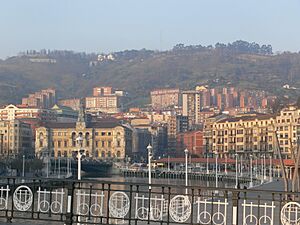Arenal Bridge facts for kids
Quick facts for kids Arenal BridgeSpanish: Puente del Arenal Basque: Areatzako zubia |
|
|---|---|

Arenal Bridge in winter
|
|
| Carries | Motor vehicles Streetcars Pedestrians |
| Crosses | Estuary of Bilbao |
| Locale | Bilbao |
| Official name | Puente del Arenal |
| Characteristics | |
| Design | Reinforced concrete bridge |
| Material | Concrete |
| History | |
| Construction begin | 1845 (original bridge) 1878 (stone bridge) 1937 (current) |
| Construction end | 1848 (original bridge) 1878 (stone bridge) 1938 (current) |
| Collapsed | April 12, 1874 (original bridge) June 19, 1937 (stone bridge) |
| Statistics | |
| Toll | Free both ways |
The Arenal Bridge is a famous bridge in Bilbao, Spain. Its name in Spanish is Puente del Arenal, and in Basque it's Areatzako zubia. This bridge is made of reinforced concrete, a very strong material.
It crosses the Estuary of Bilbao, which is like a river mouth. The bridge connects two important parts of the city: the old town called Casco Viejo and the Abando neighborhood. The Arenal Bridge you see today was finished in 1938. It's actually the third bridge to be built in this exact spot! The first one opened in 1848, and the second in 1878.
From the bridge, you can see some cool landmarks. These include the Arriaga Theater, the lovely Arenal de Bilbao park, the Estación de Concordia (Concordia Train Station), and the Bailén Skyscraper, which was the city's very first skyscraper.
Contents
A Bridge Through Time: Arenal Bridge History
Bilbao grew a lot over the years. The city center started to spread beyond the old seven streets. People needed an easier way to travel between the old town and the new areas like Abando. The only bridge crossing the Estuary of Bilbao was the San Antón Bridge. Because so many people were moving around, building a new bridge became super important. It would help connect both sides of the river.
The First Arenal Bridge: Iron and Innovation (1845-1876)
Plans for the first Arenal Bridge were made in 1844. It was built in 1845 and officially opened in 1847. This bridge was special because it was the third bridge to cross the river. It also became the main link between Bilbao and the area of Abando.
This first bridge had an iron structure. It was one of the first bridges in Spain made using casting, a way of shaping metal. It was also a moveable bridge, meaning it could open and close! The bridge was named Isabella II after the Queen of Spain. Queen Isabella II herself visited the bridge in 1865 with her son, who later became King Alfonso XII.
By 1866, the special parts that allowed the bridge to open and close stopped working. Until 1870, people had to pay a small fee, called a toll, to cross the bridge.
Over the next few years, the bridge faced many challenges. Several floods and other events caused serious damage. Some of its original arches had to be replaced with wooden sections. The bridge was damaged even more during the Carlist Wars. An attack hit the city on April 2, 1874. Then, on April 11 and 12 of the same year, a big flood partly destroyed the bridge.
In 1876, one of its old arches was moved to the Udondo River in Leioa, where it still stands today.
The Second Arenal Bridge: Stone and Trams (1878-1937)
After the first bridge was destroyed, a new plan was approved in 1876. This new design by Adolfo de Ibarreta featured a bridge with three arches made of strong stone. The new stone bridge opened to the public on December 1, 1878.
This new bridge changed how boats could travel on the river. Only barges and small steam boats could pass under it. This bridge was also called Isabella II. It had a wider surface for traffic, which meant tramways could now use the bridge to connect both sides of the river.
In June 1937, during a conflict known as the Civil War, this stone bridge was destroyed. A temporary bridge made of wood and barges was quickly built in its place.
The Current Arenal Bridge: Reinforced Concrete (1938-Present)
In June 1938, a brand new bridge was opened in the same spot where the old Isabella II bridge used to be. This new bridge was built using reinforced concrete, making it very strong and modern for its time. It was first named Puente de la Victoria (Victory Bridge).
In 1980, the bridge's name was changed to its current one, Puente del Arenal (Arenal Bridge). It has been serving the people of Bilbao ever since!
Images for kids
See Also
 In Spanish: Puente del Arenal para niños
In Spanish: Puente del Arenal para niños
- Abando




